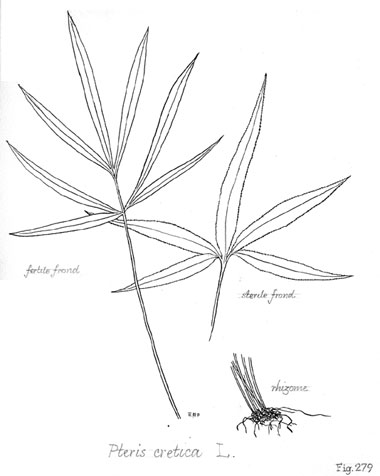|
Hardy Fern Home P. cretica resources
All Ferns � Pteridaceae �� Pteris
�Other Genera
|
| Pteris cretica | ||
Cretan brake | ||
|
Etymology
Cretica refers to the island of Crete.
Description
Rhizome: short-creeping, scales minute, dark brown to chestnut brown.
Frond: 60 cm high by 25 cm wide, deciduous in colder areas, dimorphic, blade/stipe ratio: 1:1 or less. Stipe: dark brown to straw-colored at the base, sparsely scaly at base, glabrous above, vascular bundles: 1. Blade: 1-pinnate, irregularly ovate, papery, pale green, glabrous. Pinnae: 2 to 5 pair, linear, lowest pair forked, lower pinnae short-stalked, upper sessile, fertile pinnae contracted; margins fertile entire, sterile serrate; veins conspicuous, free, simple or once-forked. Sori: continuous, submarginal, indusium: false, reflexed margin of pinnae stiff, pale brown, sporangia: yellowish brown. Culture
Habitat: limestone ledges and rocky meadows.
Distribution: pan tropical and subtropical, native range unknown.
Hardy to -15�C, USDA Zone 7.
Synonyms
Pycnodoria cretica (Linnaeus) Small |
|
|

Pteris cretica. �Illustration by Edgar Paulton, from How to Know the Ferns and Fern Allies, John T. Mickel, � 1979 Wm. C. Brown Co. |
Pteris cretica. Habit. Maui, Hawaii. �Photo by Forest & Kim Starr (USGS) |